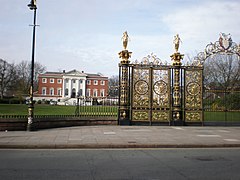Warrington
| Warrington | ||
|---|---|---|
| Town Hall with entrance gate | ||
| Coordinates | 53 ° 23 ′ N , 2 ° 36 ′ W | |
|
|
||
| Residents | 202,700 (as of 2011) | |
| administration | ||
| Post town | WARRINGTON | |
| ZIP code section | WA1-WA5, WA13 | |
| prefix | 01925 | |
| Part of the country | England | |
| region | North West England | |
| Ceremonial county | Cheshire | |
| Unitary authority | Warrington | |
| Website: www.warrington.gov.uk | ||
Warrington is a town on the River Mersey in the Warrington Unitary Authority in north-west England . It has around 194,000 inhabitants.
history
Warrington was founded by the Romans at a point on the Mersey where the Roman soldiers crossed the river to get to their camp in Deva (now Chester ) to the north . The settlement was abandoned in the 5th century and re-founded by the Saxons in the 9th century . Around 1070 the Normans built a wooden castle in Warrington. At the beginning of the 11th century Warrington developed into a small market town.
In the late Middle Ages , Warrington was still a small town of a few hundred inhabitants; because of its stone bridge built in 1495 over the Mersey, however, it gained more and more importance. Warrington had a population of around 2,000 during the English Civil War , but was strategically important because of its bridge over the Mersey. In 1642 the monarchists occupied the city, but the following year it was captured by parliamentarians after a siege and held until the end of the war. Both Oliver Cromwell's and the Earl of Derby's troops camped near the town. Rumor has it that notches in the walls of the parish church are from cannons used in the Civil War.
In 1847 Warrington was granted county borough status. Warrington developed into a center of various industries ( steel , especially wire , textiles , chemicals ) and breweries and in 1901 had just under 65,000 inhabitants.
Warrington today
The heavy industry fell sharply in the 1970s and 1980s, but the technology and service companies took their place and, for example, a production facility for dietary supplements .
Local attractions include Warrington one asked listed Transporter Bridge in 1916 and the Alice in Wonderland statue, in honor of Lewis Carroll was built.
Warrington is a rail hub and has two stations on main lines. The station Warrington Central is located on the railway line between Manchester and Liverpool . This line and its Warrington station were opened in 1873 by the Cheshire Lines Committee . Warrington Bank Quay Station is on what is now the West Coast Main Line and was originally built by the London and North Western Railway . The station Warrington Bank Quay is known for its immediately adjacent to the tracks Unilever known -Fabrik. The two train stations are at opposite ends of the city's shopping center and are connected by a shuttle bus service on weekdays.
Warrington is close to the M62, M6 and M56, and about halfway between the airports of Liverpool and Manchester . The Manchester Ship Canal runs through the city, dividing it in half. The Bridgewater Canal , an early canal construction dating from the industrial revolution, is also nearby . Back then, horse-drawn narrowboats were used as a means of transport . Today the canal is used almost exclusively by recreational captains.
The main sports club in Warrington are the Warrington Wolves , a rugby team.
The song Zombie (1994) by Irish rock group The Cranberries was written in memory of three-year-old Jonathan Ball and twelve-year-old Timothy Parry, who were killed in an IRA bombing in Warrington on March 20, 1993.
Warrington has twinned cities with Hilden ( North Rhine-Westphalia ), Jaroměř and Náchod ( Czech Republic ).
sons and daughters of the town
- Sue Johnston (born 1943), actress
- Pete Postlethwaite (1946-2011), actor
- John Richards (born 1950), football player
- Barry Alexander Brown (* 1960), director and film editor
- Ian Brown (born 1963), musician
- Polly Walker (born 1966), actress
- Phillip Archer (* 1972), golfer
- Chris Braide (* 1973), singer, composer, songwriter and music producer
- Warren Brown (born 1978), actor
- Kerry Katona (born 1980), singer
- James Chester (born 1989), football player
- Jesse Lingard (* 1992), football player
- Jack Robinson (born 1993), football player
- George Sampson (* 1993), dancer, actor, singer
- David Brooks (born 1997), Welsh football player


